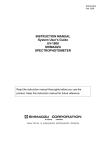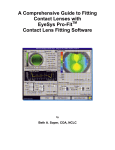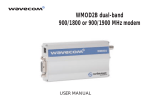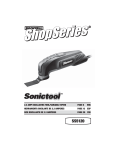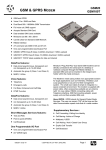Download RADTriage50 - USER MANUAL
Transcript
RADTriage50 - USER MANUAL Read and follow the instructions provided on the dosimeter and in this manual. RADTriage50, a member of the SIRAD® family of dosimeters, is a personal casualty, acute dose dosimeter. It is intended to be used for monitoring medically significant dose in an event of a radiological incident, such as an accident at a nuclear power plant or, a nuclear or dirty bomb explosion. It supplements, but does not replace, any other devices that a user may be required to use. It has two monitors: (1) the sensor (central rectangular strip in the center) which monitors ionizing radiations above 50 mSv (yearly allowed dose limit for occupational workers in USA) and (2) a FITTM indicator (located on the right hand end of the sensor with four to nine dark dots) which monitors tampering, service life and the effects of undesired ambient conditions. When received, the area surrounding the dark dots of the FIT indicator should be lighter than the colored reference bar on its right. Sensor Sensor’s “Reference” FIT Indicator How to read the exposure/dose: The dosimeter is always active and ready to use. It should not be used for monitoring dose below 50 mSv, even though it may indicate a lower dose. The sensor’s color must be lighter than that of the “Reference” bar above it on the right when received The sensor instantly develops color upon exposure of gamma/X-ray and the color intensifies with increasing dose. Color development is permanent and cumulative. Exposure dose can be estimated with an uncertainty of about 20% by comparing the color of the sensor with the color reference bars printed on the top and bottom of the sensor under fluorescent light. If the sensor develops a color in-between any two adjacent reference bars, it indicates an in-between dose. RADTriage50 exposed to 250 mSv mSv Sensor’s limitations: The sensor has the following major limitations and/or undesired properties: The sensor monitors gamma/X-ray (energy higher than 30 KeV), high energy electrons/beta particles (e.g., above 0.5 MeV) and neutrons. It will not monitor alpha particles. The sensor will not monitor dose from diagnostic X-ray (e.g., chest or dental) or security X-ray machines. Multiple (e.g., about ten) exposures to medical or airport luggage and CAT scans may result in sufficient exposure to produce a detectable color change in the sensor. The radiated sensor, especially above 1,000 mSv is bathochromic (i.e., it displays different color shades under different lights). In an event RADTriage is exposed to such a high dose, estimate the exposure under fluorescent light. The sensor has slight thermal reactivity and therefore has a service life of two years at room temperature (25oC/77oF). Avoid prolonged exposure to heat. The sensor develops faint color upon prolonged (e.g., a couple of days) exposure to UV/Sunlight. Avoid prolonged exposure to UV/sunlight. FIT Indicator: The sensor also develops faint color upon prolong exposure to heat and UV light and hence RADTriage is equipped with an indicator (FIT) for monitoring such exposures. If used as per instructions, it is least likely that sensor will provide false positives or negatives. The FIT indicator simultaneously monitors (1) service-life and, false positives and negatives from overexposure to heat & UV/sunlight which will be indicated by the darkening of the area surrounding the dark dots and (2) inactivation or altered sensitivity (i.e., change of dose calibration) which will be indicated by the FIT changing to red. If the FIT is not red, the sensor is active and the calibration of the sensor is valid. If RADTriage50 is exposed to heat above 95oC/203oF, the FIT will change to red indicating an altered sensitivity of the sensor to radiation and hence the dose calibration is not valid. Replace the dosimeter if the FIT is red. FIT is an indicator and as it monitors many parameters simultaneously, the uncertainty in monitoring the service life is high (~50%). Service life: The estimated service life of dosimeter is two years at room temperature in the absence of contributions from other environmental effects. Depending upon the time, the temperature above the room temperature, and/or UV/sunlight exposure, the service life will be reduced proportional to the exposures. Service life can be extended to about ten years if stored in a freezer below -15oC/5oF when not in use. Service life expires when (i) the area surrounding the dark dots of the FIT matches or becomes darker than the color reference bar on its right, (ii) FIT is red or (iii) the color of the sensor matches the “Reference” bar above it. Replace the dosimeter upon expiration of service life. (i) ( ii ) ( iii ) Examples of expired service life / when to replace Replacing RADTriage: Replace RADTriage when one or more of the following occur: Two years of use at room temperature or ten years of storage in a freezer at -15oC/5oF. When the sensor develops a color that matches or is darker than the “Reference” bar above it. When the area surrounding the dark dots of the FIT indicator matches or becomes darker than the color reference bar on its right. If the FIT is red. Additional information: For additional information or questions related to RADTriage visit www.jplabs.com or contact: JP Laboratories, Inc. 120 Wood Avenue Middlesex, NJ 08846 USA Phone: (732) 469 6670 Email: [email protected] LIMITED LIABILITY: RADTriage50 is expected to perform as specified if used as recommended and when instructions are followed. In an event that the product does not perform as specified, JP Labs will replace the product. JP Labs specifically disclaims all other warranties and liabilities expressed or implied. All warranties are null and void if (1) the FIT indicator is red/purple and/or area surrounding the dots of the FIT matches or is darker than that of its color reference bar, or (2) RADTriage50 is tampered with in any way.



